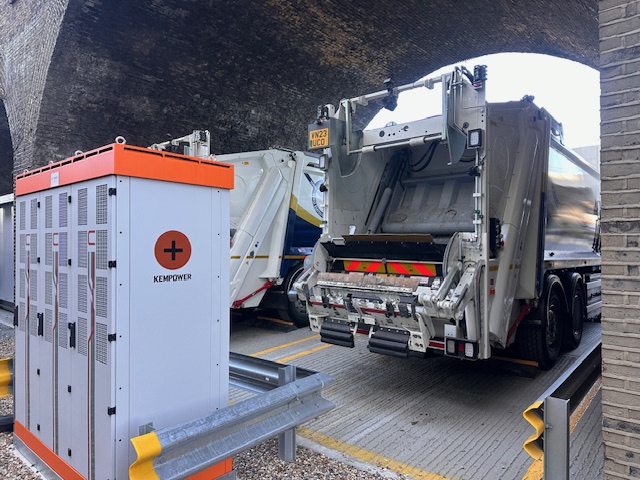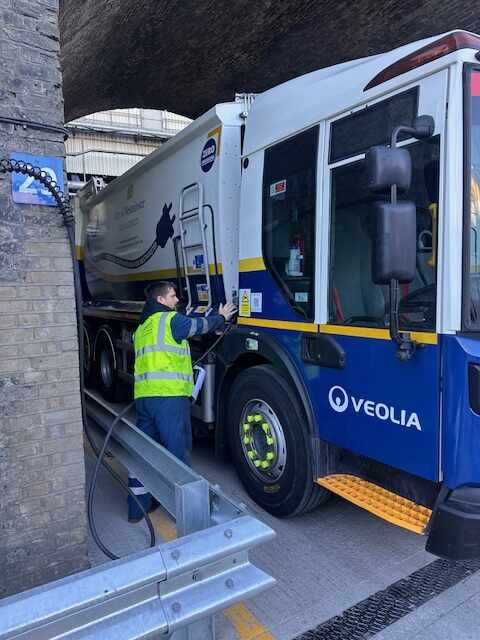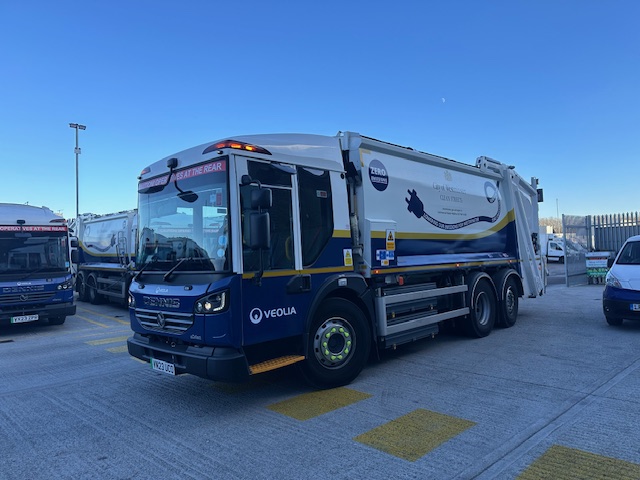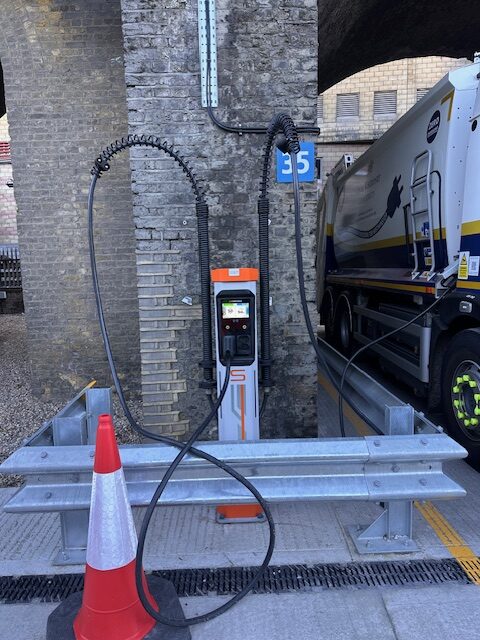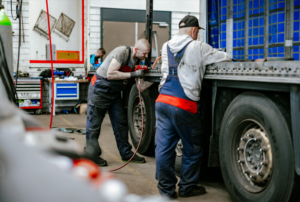Westminster City Council and Veolia UK have rolled out the UK’s largest electric refuse collection fleet powered by an energy-from-waste facility—a world first for the local authority municipal fleet industry. Fleet Vision International met the council’s Waste & Recycling Manager, Jarno Stet, and Contracts Manager, Ed Yendluri at the project’s launch.
The 45 new electric trucks in the Westminster City Council (WCC) fleet are housed at the specially designed and refurbished Landmann Way Depot near Bermondsey in South East London, which is fitted with smart charging infrastructure. The 27-tonne vehicles were delivered in July 2023 and will provide a cleaner, quieter service to residents powered directly by the energy generated from the waste they collect.
Jarno Stet, Waste and Recycling Manager at Westminster City Council believes the project sets a new benchmark for the waste industry and beyond. Developed under the leadership of Contracts Manager Ed Yendluri, the council has invested £20 million in the initiative, which will directly benefit residents, local businesses, and visitors by reducing vehicle noise, cutting air pollution, and drastically lowering the borough’s carbon emissions.
The electric vehicles will charge their batteries by drawing electric power from the energy recovery facility South East London Combined Heat and Power, better known as SELCHP. This is a major energy-from-waste incineration plant in South Bermondsey, located next door to the Landmann Way Depot and connected via a private wire (PPA), It uses the waste collected from homes and businesses in Westminster to generate electricity, which WCC uses to power its electric fleet.
Westminster’s fleet, operated by Veolia, carries out 50 million collections every year, and each electric vehicle saves up to 89% CO2e compared to a diesel equivalent. Smart charging will allow the partnership to support the National Grid by receiving power at non-peak times to maximise local resources and strengthen the grid’s resilience.
The project, which was inspired by the London Transport Strategy and WCC’s air quality and climate emergency policy, took around five years to get from concept to reality. Air pollution is a significant problem in Westminster, which has some of the worst air quality in Europe. This decarbonisation project has eliminated around 2,600 tonnes of CO2e PA, equivalent to removing 1,300 cars from Westminster streets.
The council’s determination to decarbonise its fleet and reduce its transport carbon footprint was backed by Innovate UK funding, which enabled Westminster to test new fleet technologies such as upcycling end-of-life diesel trucks to fully electric and test hydrogen-powered trucks in WCC. Technologies such as CNG and HVO were also tested to ensure the best possible fleet solution was selected for the council specific circumstances. ‘After thorough testing of various alternative fuel technologies, Westminster selected electric-powered trucks as the best solution to meet the council’s aspirations and cut emissions,’ says Contracts Manager Ed Yendluri.
‘There weren’t any large electric trucks on the market at the time we initiated this project, so we experimented with building our own by upcycling old diesel trucks. However, when Dennis Eagle came out with the eCollect, and Electra launched its first vehicles, we tested these models to ensure they could cope with a million collections a week and would stand up to the pressure of Westminster’s congested roads.’
He adds: ‘One of the main barriers that electric vehicles face is charging infrastructure. Establishing an adequate power supply, which would be in the megawatts range, is a real challenge in London and the UK generally. In most cases, the distribution network operator needs to upgrade the local grid infrastructure and put new cables in, which all represent substantial costs, and not all sites are suitable because of this limitation.’
‘Westminster, in partnership with Veolia, found a piece of land under the railway arches right next to the energy-from-waste plant,’ says Jarno. ‘By opting for the PPA private wire arrangement, we have significantly lowered the carbon footprint of the power generated, and the infrastructure also came at a substantially lower cost than the grid connection, making it a win-win situation for both SELCHP and WCC.’
The private wire with integrated super-smart charging infrastructure enabled Westminster and Veolia to manage the process in-house. It means they can charge the vehicles at a time when it least impacts the power from the waste plant, which is under restriction because it needs to surge electricity back to the grid when demand is highest. The Westminster fleet charges when the demand from the grid is lowest via a unique algorithm that calculates usage and saves on power costs.
The site opened last July, and before Westminster and Veolia took it over, it was a body workshop and a taxi yard. A complete infrastructure overhaul was required, such as installing charging cables, a substation, lighting, and stringent fire protection measures, including infrared fire detectors that scan the whole yard for heat sources. This is because the depot is under a main railway line, so it was essential to eliminate or minimise any fire risk from the battery technology.
Both the council and Veolia report that the new electric Dennis Eagle fleet has been performing exceptionally well. ‘This has never been done on this scale before, and so far, it has been working great,’ says Ed. ‘We’ve had great technical support from Veolia, Dennis Eagle and all our project partners, which has allowed us to set an example for local authorities in the UK and beyond.’
Westminster City Council built a solid business case and explored every option to tap into funds and grants to make the project work. Thanks to the Mayor of London’s Energy Efficiency Fund (MEEF), a £500 million investment fund established by the Greater London Authority that aims to deliver the low carbon, sustainable projects and infrastructure London needs to tackle the climate emergency, WCC secured the right finance models and advantageous borrowing rates. Now the fleet is in operation, it is also saving on fuel and maintenance.
Nevertheless, the council is taking a cautious approach. ‘We try not to work the fleet to the bone because vehicle life depletes rapidly when you double or triple shift,’ says Jarno. ‘We have got vehicle allocation down to fine art to ensure we always have the capacity. Our operations can’t stop, and the fleet needs to be up to the task.’
The drivers are enthusiastic about the new fleet. ‘Most vehicles are allocated to specific drivers, as we like our drivers to take pride in the trucks they operate,’ he says. ‘Coupled with an ongoing driver training and management programme, the crews look after these vehicles like they look after their own.
‘They like the acceleration of the trucks and their smooth operation. From a health perspective, drivers appreciate that the RCVs are silent in operation and that they no longer have to work in the exhaust fumes. The lack of noise also benefits residents, businesses and visitors. Even when you run the compaction, you can only hear the humming of the hydraulics and the batteries.’
The new 27-tonne waste electric trucks have a 360-degree camera system that records all traffic situations around the vehicle and helps with accidents and insurance claims. These recordings are also used for VR training so operatives can learn about risks in a simulated environment, which Ed and Jarno believe is more effective and immersive than classroom-style learning.
Jarno and Ed put the success of this pioneering electric fleet down to the meticulous preparations of both Westminster City Council and Veolia, which together worked out every aspect of its operation. Programme leader Ed Yendluri and his team have proven that it is possible to run a large fleet of electric RCVs efficiently, despite many operators saying the technology isn’t there yet. Unsurprisingly, Ed has already scooped many awards for this project.
Ed will speak about this initiative at Fleet Vision International – THE SHOW held at the Guildhall on April 11. You can register for free to see his presentation here.






